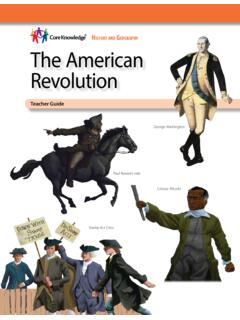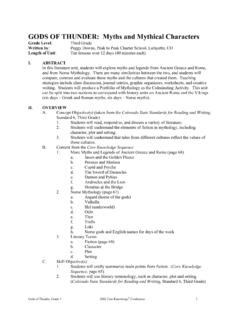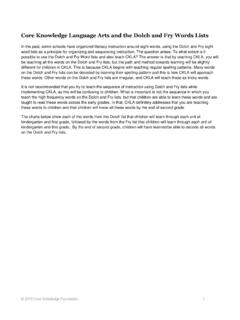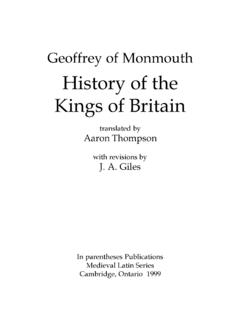Transcription of Teacher’s Guide to The Core Classics Edition of Alice M ...
1 Teacher s Guide to The Core Classics Edition of Alice M. Hadfield s KING ARTHUR And THE ROUND TABLE by Jennifer England Core Knowledge Foundation, 2005 This on-line Edition is provided as a free resource for the benefit of Core Knowledge teachers and others using the Core Classics Edition of King Arthur and the Round Table. Resale of these pages is strictly prohibited. 2 Table of Contents Introduction - King Arthur, Man or Myth? .. 3 Teaching Notes .. 7 Chapter Summaries Part I: Chapters 1 10 Part II: Chapter 6 8 .. 14 Part III: Chapters 9 15 .. 17 Part IV: Chapters 16 21 Student Activities Part I.
2 26 Part 38 Part 46 Part 58 Culminating 68 Teacher Answer Guide .. 69 Appendix Important 83 Who s 84 Semantic Word 89 Map of Arthur s 90 Bibliography .. 91 3 As the hero of Malory s story, Arthur tries to rule fairly in peace and prosperity. He enlists the best fighters in Briton to join the fellowship of the Round For the sake of those suffering under justice, they face danger alone to enforce the law and punish the The quest sets a hundred knights roaming the roads of Britain, seeking something invisible to them. Chivalry, putting its trust in the survival of the fittest, requires a knight to look for action and to put himself at the mercy of chance.
3 The death-defying heroes of the Round Table hurl themselves into single combat with unknown foes at an Camelot's bonds of brotherhood, eaten at by greed and jealousy, unravel into civil war. The spirit of revenge hacks away the body of the Round Badly wounded in combat, Arthur is taken for healing to Avalon, the island in Celtic myth, where the dead Yet for a time, justice and goodness, order and peace reign from Excerpts from the Introduction of King Arthur by Hirsch, Jr. Introduction: King Arthur, Man or Myth? For the past fifteen hundred years, stories of a legendary king and his court have come to symbolize all that is noble and good.
4 The story of King Arthur and his knights is the tale of a time of peace, justice, and brotherhood. It is the story of Knights, living by a Code of Chivalry, who created briefly an ideal world based on honor and good deeds. It is the story that ends in betrayal and tragedy, but it leaves us with the hope that another such time might come again. Sources for the Arthurian Legends Le Morte d Arthur is the source of the Arthurian legend used in the Core Knowledge Classic, King Arthur and the Round Table, adapted by Alice M. Hadfield. Le Morte d Arthur is based on a collection of stories written by Sir Thomas Malory and edited and printed by William Caxton in 1485.
5 Until a few years ago Le Morte d Arthur's author, Thomas Malory, was little known. It is probable that he was Sir Thomas Malory, born about 1400 of an old Warwickshire family. He loved hunting, tournaments, and chivalry and was well versed in the Arthurian romance of his day. He spent much of his life in prison, some say because he was a violent man; others say because he was a politically unpopular either case, his days in prison allowed him the opportunity to pen his classic. Originally his work was called The Book of King Arthur and His Noble Knights of the Round Table. Based on assorted tales, the book was a compilation of beautifully written French and English stories, put together without great skill.
6 Malory s Arthur may have been forgotten had it not been for William Caxton, who effectively reorganized and edited Malory s tales into Le Morte d Arthur. Born in Kent in 1422, William Caxton was England s first printer. He produced 100 books and pamphlets including The Canterbury Tales. Many were his own translations and contained his own prefaces. He published only what he thought was the best writing of his day. He is known for shaping and standardizing the English language. He thought the knights of his day were un- 4 Arthurian so he published the Order of Chivalry to accompany Le Morte d Arthur giving Malory credit as the author.
7 This 1485 Malory Edition has become the definitive version of King Arthur and his Knights of the Round Table. Historical Model and Historical Context of Arthur s Story Who was the model for Malory s chivalrous Arthur? Was it the Earl of Warwick he served under in the French Wars and man whom all of Europe recognized as embodying the knightly ideal of the age? Or did Malory s enthusiasm for chivalry come from the English king at the time, Henry V, whose feats were similar to Malory s Arthur? We ll never know. But we do know much of Malory s story was based on previous writings mainly those of geoffrey of monmouth . geoffrey of monmouth became the first and one of the most important authors of Arthurian legends.
8 Three of his works survive today: Prophecies of Merlin, Historia Regum Britanniae, and Life of know little of his personal history . His full name seems to have been geoffrey Arthur Arthur being the name of his father. He was educated at the priory in monmouth and was consecrated bishop in 1152. He died in 1155. In 1136 geoffrey began writing his Historia Regum Britanniae ( history of the Kings of Britain). He claims to have used an ancient book, the British Book, containing authentic historical documents. Through his life in the monastery, he became familiar with Welsh and Breton folklore, which founds its way into his history .
9 In the first chapters of The Historia, geoffrey traced the origin of Britain, telling of legendary and actual events. The Arthurian portion is the climax of the Historia. The Celtic victory over the Saxons was followed by a Golden Age of peace during which Arthur established the fellowship of Knights. The Saxons eventually overpowered the Britons who retreated into Wales. The Historia ends in 689 with Merlin s prophecy of a return to power by the Celts. Fusing the popular stories about Arthur with the few documents he had access to, geoffrey found a way to satisfy the courtly readers of his day. Romance was in demand; geoffrey modernized Arthur s court to accomodate 12th century customs.
10 His sources probably included Gildas The Wise (504 570) a sixth century monk who wrote Concerning the Ruin of Britain written references to an Arthurian figure begin with his work and Nennius, a Welsh monk who wrote about AD 800. Nennius was the first to refer to Arthur. In his Historia Brittonum, Nennius, describing Arthur s great victories over the Saxons said, The twelfth was the battle at Mount Badon, in which, on one day, nine hundred and sixty men fell to the ground during one onset of Arthur; and no one overthrew them save himself alone; and in all the battles he emerged the victor. At the time it was written, The Historia was accepted as a true record of the Welsh from 1100 BC to AD 689.










